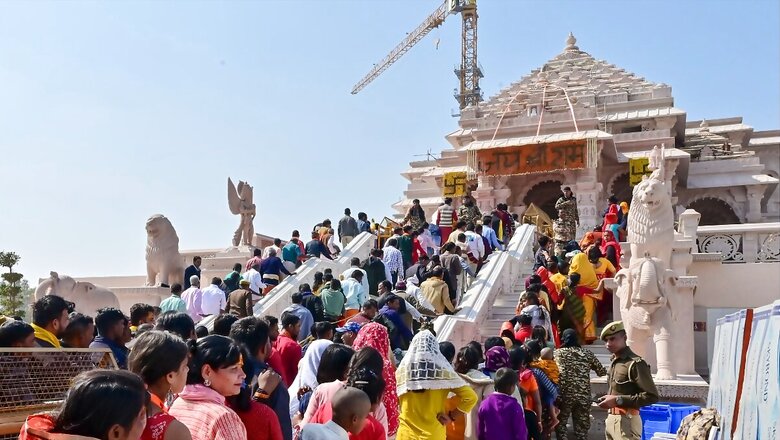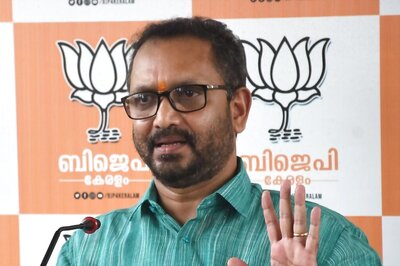
views
The 2024 general elections have concluded, and the results have generated considerable discussion. The INDIA coalition’s performance exceeded expectations, impacting the BJP’s anticipated dominance. While the BJP had projected a significantly higher seat count, the actual results fell short of their projections. The Uttar Pradesh outcomes, particularly the loss in the Faizabad (Ayodhya) constituency, were unexpected for the party.
The significance of the Ram Mandir, a long-held aspiration for many BJP supporters, contributed to expectations of a comfortable victory in Faizabad. However, the BJP candidate, 70-year-old incumbent BJP MP Lallu Singh was unseated by Samajwadi Party’s (SP) Awadhesh Prasad, who won by a margin of 54,567 votes. While this margin might not be considered substantial in the context of national parliamentary elections, the loss itself carries symbolic weight for the BJP. Therefore, it’s essential to analyse the factors that contributed to this unexpected outcome in the city of Lord Ram.
Selection of Candidates
The Faizabad (Ayodhya) Lok Sabha constituency comprises five Vidhan Sabha constituencies: Dariyabad, Rudauli, Milkipur, Bikapur, and Ayodhya. The BJP held four of these except Milkipur, where the Scheduled Castes and Muslim demographic plays a pivotal role in determining electoral outcomes. In the 2024 general elections, the BJP secured victories in Rudauli, Bikapur, and Ayodhya but faltered in Dariyabad and Milkipur. The SP candidate, Awadhesh Prasad, an incumbent Member of the Legislative Assembly (MLA), managed to secure a lead from his home constituency of Milkipur as well as Dariyabad. The BJP’s leads in the remaining three constituencies were insufficient to counter these losses.
Both candidates are seasoned politicians with substantial experience and accomplishments in their respective careers. BJP’s candidate, Lallu Singh, held the parliamentary seat for two consecutive terms and had previously served as an MLA on five occasions. On the other hand, SP’s candidate, 78-year-old Awadhesh Prasad, was an incumbent MLA from Milkipur and had been elected to the state legislature nine times. Having contested elections since 1974, Prasad’s ascension to the Lok Sabha came 47 years after his initial MLA victory. Notably, he also served as a minister in the Uttar Pradesh state government on six different occasions.
Prasad’s stature as a veteran politician who has consistently delivered electoral triumphs is undeniable. Lallu Singh, on the other hand, had purportedly lost touch with the grassroots over the past five years, according to local accounts, prompting public dissatisfaction with his candidacy. However, the BJP disregarded these sentiments and persisted with his nomination. Conversely, the Samajwadi Party banked on a Scheduled Caste leader with robust local connections and expertise, a strategy that yielded the desired outcome for the INDI alliance.
M-Y Equation, SC Votes and Infrastructural Development
The Muslim-Yadav (M-Y) vote bank had already exhibited an apparent inclination towards the Samajwadi Party in Uttar Pradesh and the INDI alliance at the national level. Awadhesh Prasad, hailing from the Scheduled Caste community, managed to secure a significant portion of the Scheduled Caste votes.
The anti-incumbency sentiment cannot be disregarded, as Lallu Singh had been the incumbent Member of Parliament since 2014, and the electorate had repeatedly expressed dissatisfaction with his tenure.
Despite the BJP government undertaking developmental projects such as the construction of wide roads, highways and airports and the renovation of the railway station in Ayodhya, widespread corruption in the disbursement of compensation funds led to discontentment among the local populace.
Furthermore, the lack of infrastructural development in the areas surrounding Ayodhya contributed to the BJP’s defeat in the Faizabad constituency. The concentration of infrastructural development and illumination within the urban areas of Ayodhya resulted in the upliftment of a specific section of society, which fueled resentment among the local populations of the Dariyabad and Milkipur Assembly constituencies.
A Sense of Distrust
Prior to the election, the BJP’s decision to induct numerous local leaders who had previously opposed the party and its local cadres engendered a sense of trepidation and mistrust among the party’s established grassroots workers (karyakartas). This development, the significance of which the BJP’s central leadership underestimated, played a role in the party’s defeat.
Lallu Singh, accompanied by the BJP karyakartas, maintained a conspicuous absence from on-ground campaigning efforts, instead opting for a heightened presence on social media platforms. Conversely, the Samajwadi Party’s karyakartas and Awadhesh Prasad dedicated substantial efforts to grassroots campaigning, engaging the electorate on local issues. This strategic approach enabled the SP to augment its vote share, ultimately propelling it to victory.
The BJP’s defeat in Ayodhya, the epicentre of the Ram Mandir movement, signifies a shift in political dynamics. The results underscore the importance of local issues, candidate selection, grassroots campaigning, and the need for inclusive development. This election outcome should prompt the BJP to reassess its strategies and prioritise effective governance.
Anmol Kumar is a Research Assistant for an ICSSR Project at Pondicherry University. He regularly writes about domestic politics, foreign policy, and geopolitics. Views expressed in the above piece are personal and solely those of the author. They do not necessarily reflect News18’s views.
















Comments
0 comment